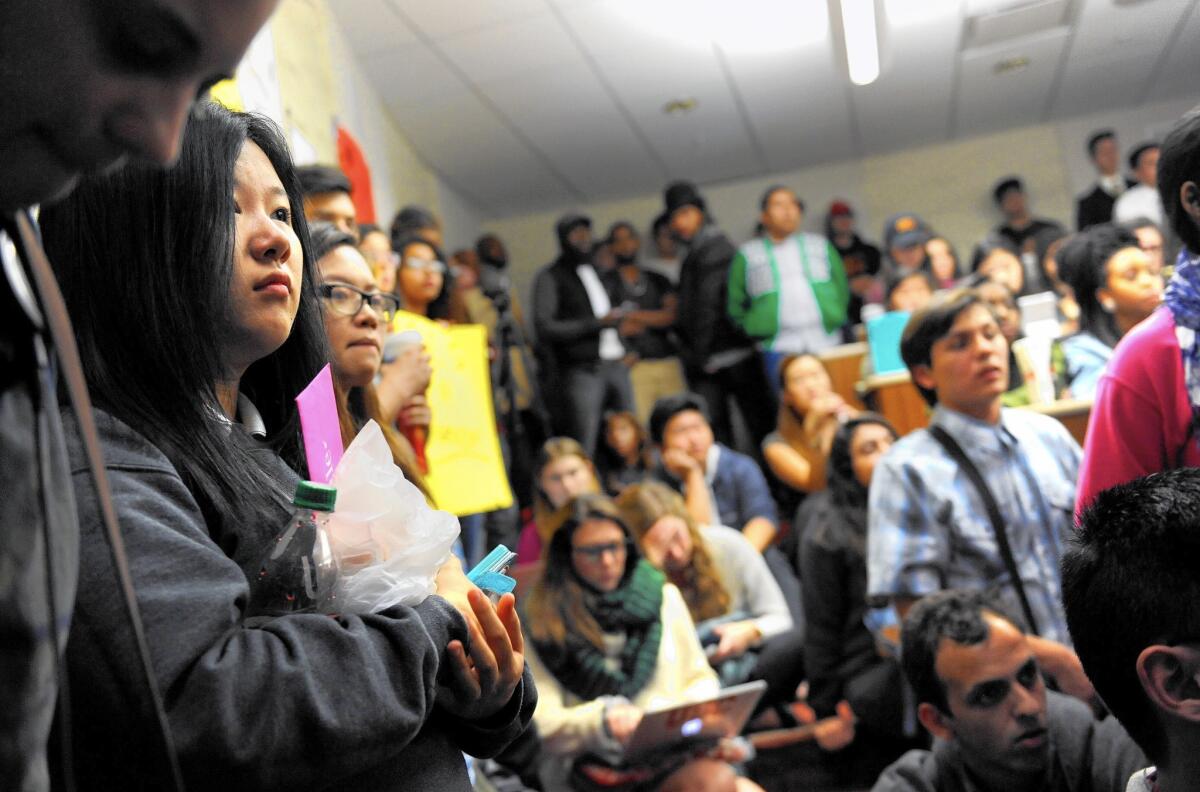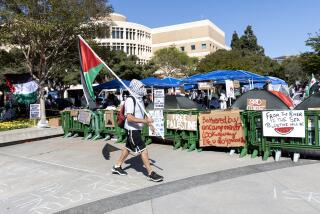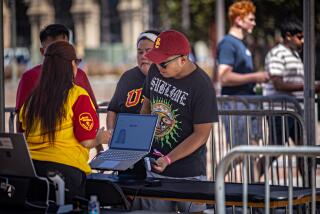College students confront subtler forms of bias: slights and snubs

Students listen as the USC Student Government votes Tuesday on a resolution to increase diversity.
USC junior Vanessa Diaz was raised in Dallas. But at a party two years ago, she was asked if she could speak English.
When Diaz became offended, the other student tried to pass off the question as a joke. But it did not amuse her, any more than the idea of Mexican-themed parties on Greek Row featuring students in sombreros and fake mustaches.
âBecause of the society we live in, itâs not OK to be overtly racist,â Diaz said. âBut that doesnât mean everything is OK.â
Some call it the new face of racism â not the blatant acts of bias that recently led to the University of Missouriâs campus unrest and resignation of the president and chancellor. Instead, a phenomenon known as âmicroaggressionâ â everyday slights and snubs, sometimes unintentional â is drawing widespread attention across college campuses and kicking up a debate about social justice and free speech rights.
Students are sharing their experiences with microaggression on websites and Facebook pages at Harvard, Oberlin, Brown, Dartmouth, Swarthmore, Columbia, Willamette and other universities.
In the last eight years, researchers have conducted more than 5,500 studies on the topic documenting how such seemingly minor slights harm student performance, mental health and work productivity, said Derald Wing Sue, a Columbia University psychology professor and leading expert on the topic.
University of California President Janet Napolitano invited faculty members last year to take training in recognizing microaggression and the messages they send. One handout, adapted from Sueâs research, offered examples: Telling people of color they speak English well sends a message they are perpetual foreigners in their own land or asserting that America is a âmelting potâ denies the significance of a personâs racial or ethnic experiences.
Some critics, however, say they worry that the microaggression movement chills free speech, increases conflict and perpetuates an aggrieved sense of victimhood.
Bradley Campbell, a an associate professor of sociology at Cal State Los Angeles, said the movement is transforming society from a âdignity culture,â in which people are taught to have thick skins and refuse to allow others to affect their sense of self-worth, to a âvictimhood cultureâ that advertises personal oppression.
Such a shift, he argued, could increase mental health problems and 1st Amendment conflicts, such as campus speech codes and the recent attempt by University of Missouri students to bar journalists from entering a public area they deemed their âsafe space.â
He also said that labeling those who unintentionally offend as aggressors seemed harsh, potentially creating more conflict and alienation among groups.
Others defend the focus on microaggression as the next step forward in the countryâs long, slow march toward greater equality and understanding.
Rini Sampath, USCâs student body president of Indian descent who drew national attention when she wrote on Facebook about an ethnic slur hurled at her, said microaggressions should not be shrugged off as trivial.
âPeople are going to dismiss us ⌠because they say itâs political correctness gone too far,â she said. âBut every day, students walk into a room and someone makes fun of their accent or [gets] kicked out of parties, and we have to take those things seriously. Microaggressions lead to macroaggressions.â
Jerry Kang, a professor of law and Asian American studies at UCLA, said explicit bias may be less visible today, but a growing body of mind-science research has documented that even people who donât consider themselves bigoted take actions belying that. Such implicit biases have been correlated with such behavior as job interview callbacks, hiring men over women, use of police force and funding of minority student organizations, he said.
âThe microaggression conversation has helped all of us,â said Kang, who was named this year as UCLAâs first vice chancellor for equity, diversity and inclusion. âHaving multiple vocabulary and methods for measuring how fair and square we are is always a good thing for society.â
But students say itâs not always easy to call out such slights. At UC Berkeley, Spencer Pritchard, a biracial student majoring in political economy and African American studies, said he tried to laugh off jests by his white and Asian American floormates who expressed surprise that he was articulate and good at math.
âAfter the fact, I got frustrated and wondered why I let that slide,â he said. âIâd like to not let it bother me if I didnât see black people disproportionately going to prison, dying at the hands of police or being pulled by their hair in classrooms. Microaggressions are part of a bigger picture.â
At UCLA, Filipino American student Kevin Casasola said he has learned to recognize the harm caused by seeming innocuous slights and is more willing to voice his discontent with them. He said his peers will sometimes ask where he is âreally fromâ after he tells them he was raised in Temecula.
âThe covert underlying message is âOh, I donât believe youâre from here,ââ said Casasola, a third-year statistics major. âIt perpetuates an idea of xenophobia.â
At USC, undergraduate student leaders escalated their campaign against campus bias Tuesday, passing a resolution asking the university to hire administrators to oversee diversity, hold sensitivity trainings and set aside $100 million for scholarships, programming and mentorships for minority students and faculty.
One resolution supporter was Leslie Berntsen, a psychology graduate student whose mother is Nicaraguan and father, white. When she was applying to graduate schools, she said an admissions officer expressed surprise at her high test scores and encouraged her to apply for a scholarship for minorities.
âThe implication is that Hispanics couldnât score so high on tests,â she said.
Berntsen said that such incidents donât compare with problems of previous generations but are a sign that society still is struggling with race.
âJust because weâre doing better doesnât mean weâre doing good,â she said.
A testy exchange before the vote on the resolution highlighted the continuing tensions in the microaggression debate.
A white male speaker, apparently frustrated by the discussion, questioned the need for diversity training for guest lecturers and whether one student was human at all. He told the packed room that âyou guys donât understand how endowmentsâ and university finances work.
Several students groaned, and Cynthia Blondeel-Timmerman, a junior, told the speaker she found the term âyou guysâ offensive.
âThis isnât a menâs issue,â she later said. âHow dare you come into this space and say that [females] arenât important.â
Shortly afterward, he left in a huff, declining to give his name.
[email protected]; Twitter: @teresawatanabe
[email protected]; Twitter: @byjsong
ALSO:
Vincent Asaro, 80, is acquitted in the 1978 Lufthansa mob heist retold in âGoodfellasâ
Man arrested in University of Missouri threats had âdeep interestâ in Oregon mass shooting
University of Missouri names black administrator with civil rights background as interim president
More to Read
Sign up for Essential California
The most important California stories and recommendations in your inbox every morning.
You may occasionally receive promotional content from the Los Angeles Times.












